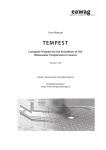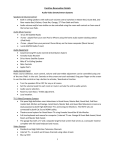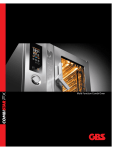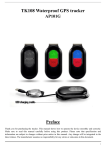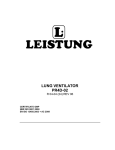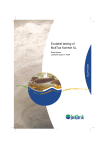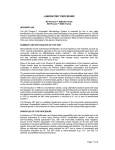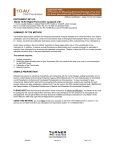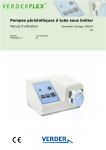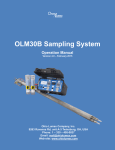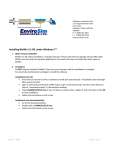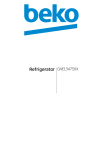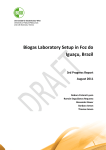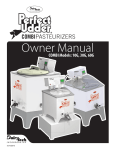Download CCN Micro AD report - The Community Composting Network
Transcript
Lettinga Associates Foundation for environmental protection and resource conservation Development of decentralised anaerobic digestion systems for application in the UK Phase 2 Client: Date: Community Composting Network (CCN) Cath Kibbler ([email protected]) 23 August 2010 Lettinga Associates Foundation PO Box 500 6700 AM Wageningen The Netherlands Tel: +31 317 482023 Fax: +31 317 482108 http://www.leaf-water.org Project number: 08-486 Authors: Els Schuman Revised by: Henri Spanjers Iemke Bisschops Final draft Interim report 18-11-2009 Table of contents Summary ................................................................................................................................................. 3 1. Introduction................................................................................................................................... 4 2. Description of the Micro AD plant................................................................................................. 5 2.1 Introduction ............................................................................................................................... 5 2.2 Conceptual design .................................................................................................................... 5 2.3 Process description .................................................................................................................. 7 2.3.1 Pre-treatment equipment................................................................................................... 7 2.3.2 Digester ............................................................................................................................. 7 2.3.3 Biogas................................................................................................................................ 7 2.4 Plant layout ............................................................................................................................... 8 3. Commercial component guide ..................................................................................................... 9 4. Start-up of anaerobic digester.................................................................................................... 13 4.1 Preparation ............................................................................................................................. 13 4.2 Start-up procedure.................................................................................................................. 13 4.2.1 Filling the reactor with inoculum ...................................................................................... 13 4.2.2 Start-up protocol applying both VFA and pH analyses ................................................... 14 4.2.3 Start-up protocol applying only pH analyses................................................................... 16 4.2.4 Monitoring parameters other than pH and VFA .............................................................. 18 4.3 Alkalinity.................................................................................................................................. 18 5. Operational manual .................................................................................................................... 20 5.1 Operation ................................................................................................................................ 20 5.1.1 Substrate ......................................................................................................................... 20 5.1.2 Shredder and pasteurizer................................................................................................ 20 5.1.3 Feeding the digester........................................................................................................ 21 5.1.4 Digestate ......................................................................................................................... 21 5.1.5 Biogas storage and capture ............................................................................................ 21 5.1.6 Hygiene ........................................................................................................................... 21 5.2 Monitoring guidelines.............................................................................................................. 21 5.2.1 Analysing parameters...................................................................................................... 21 5.2.2 pH .................................................................................................................................... 22 5.2.3 Temperature .................................................................................................................... 22 5.2.4 Volatile fatty acids (VFA) ................................................................................................. 22 5.2.5 Biogas.............................................................................................................................. 23 5.2.6 Dry matter and organic matter......................................................................................... 23 5.2.7 Pathogens ....................................................................................................................... 23 5.3 List of monitoring equipment .................................................................................................. 24 5.4 Troubleshooting ...................................................................................................................... 25 5.4.1 Acidification ..................................................................................................................... 25 5.4.2 Foaming........................................................................................................................... 26 5.4.3 Floating layers ................................................................................................................. 26 5.4.4 Sediment layer................................................................................................................. 26 5.4.5 Blockages / Leakages ..................................................................................................... 26 5.4.6 Mixer failure ..................................................................................................................... 26 5.4.7 Low gas production ......................................................................................................... 26 5.4.8 Malodour.......................................................................................................................... 27 5.4.9 Accessing the digester .................................................................................................... 27 6. HACCP outline ........................................................................................................................... 28 Annex 1: Determination of VFA with titration method ........................................................................... 34 Annex 2: Measuring methane content of biogas using sodium hydroxide ........................................... 36 CCN Micro AD Phase 2 Report - 23 August 2010 2 Summary This report describes the outcomes of phase 2 of the decentralised Micro Anaerobic Digestion (AD) project by the Community Composting Network (CCN). It describes a conceptual design of a suitable decentralized AD system for the scope specified by the CCN Steering Group, a commercial component guide, start-up procedure and operational manual for the digester. 3 The micro anaerobic digester plant has a volume of 1 m and is designed to treat kitchen waste. When operating the digester at a conservative retention time, the digester would process around 25 kg kitchen waste/d (approximately waste of 10-15 households), and produce about 3 m3 biogas/d. The overall system includes the digester and auxiliaries. The component list identifies suitable components, possible suppliers, manufacturers, alternative manufacturers and component details. Before operating the digester at design loading rate, first a start-up procedure has to be followed. The start-up of the digester, characterized as getting the reactor to work, follows a step-wise increase in feeding rate controlled by the volatile fatty acid (VFA) concentration and pH or only pH of the digester contents. The daily operation of the digester involves feeding the digester at optimal loading rate, monitoring most important parameters and troubleshooting. A list of monitoring equipment is included in the report for analyzing most important parameters during operation of the digester. To comply with regulations, especially the Animal By-Product Regulations (ABPR) the AD system has to fulfil certain requirements, which are taken into account in the conceptual design. A Hazard Analysis and Critical Control Point (HACCP) plan is included a template to support the preparation of a HACCP plan for a specific situation. This report and the Phase 1 report are both available for download from the CCN website at: http://www.communitycompost.org/index.php/projects/mad This work is licensed under the Creative Commons Attribution-NonCommercial-NoDerivs 3.0 Unported License. Permissions beyond the scope of this license may be available by contacting [email protected] or CCN, 67 Alexandra Road, Sheffield, S2 3EE, UK. To view a copy of this licence, visit http://creativecommons.org/licenses/by-nc-nd/3.0/ or send a letter to Creative Commons, 171 Second Street, Suite 300, San Francisco, California 94105, USA. We’d love to hear from any organisations or individuals who have used this report, passed it on, or who have found it interesting/informative. Please get in contact with us by visiting http://www.communitycompost.org CCN Micro AD Phase 2 Report - 23 August 2010 3 1. Introduction This report describes the outcomes of phase 2 of the decentralised Micro Anaerobic Digestion project by the Community Composting Network (CCN). The overall aim of the project is defining a suitable anaerobic digester (AD) to be able to utilise anaerobic digestion as a technology in the decentralised treatment and utilisation of bio-wastes. The system should be simple and robust, comply with regulations and produce sanitised effluent or digestate suitable for use in horticulture. The overall project is divided in three phases: In phase 1, suitable decentralized AD systems for CCN members in the UK within the scope specified by the Steering Group of CCN are identified and described. Phase 2 comprises of the development of a suitable decentralized AD system for the scope specified by the CCN Steering Group, and providing a commercial component guide and operational manual for this system. In phase 3, the construction and testing of at least one pilot plant is foreseen. LeAF was contracted to work on phase 1 and phase 2. Phase 1 report has been delivered to CCN, and precedes this report. For a good understanding of the scope and aim of the overall project as well as the anaerobic technology, identified systems, required auxiliaries and proposed design of the AD, this phase 1 report is referred to and we would recommend to people new to AD that you read the Phase 1 report first. The phase 2 report, presented here, has a summary of the proposed AD design with key information from the phase 1 report. In chapter 3 a component list is provided with details of relevant components based on recommendations of an experienced constructor. The proposed start-up of the digester is given in chapter 4, followed in chapter 5 by an operational manual in which daily operation, monitoring guidelines and troubleshooting are discussed. The last chapter, chapter 6, includes an HACCP plan outline based on existing experiences by a CCN’s members site which processes food waste in line with ABPR criteria. CCN Micro AD Phase 2 Report - 23 August 2010 4 2. Description of the Micro AD plant 2.1 Introduction The micro anaerobic digester (AD) plant is a small-scale system designed to treat kitchen waste, in this report also referred to as food waste. It is highly biodegradable material and therefore in principal suitable for anaerobic digestion. For this case study, it is assumed that there is sufficient kitchen waste available for feeding the digester. The digester is designed such that it is relatively easy to build, operate and maintain and that it fulfils the requirements set by legislation. The overall system includes the anaerobic digester and its required auxiliaries. 2.2 Conceptual design 3 The conceptual design of the system is given in Figure 2-1. The digester has a volume of 1 m . When operating at a conservative retention time (40 days), the digester would process around 25 kg kitchen waste/d (approximately waste of 10-15 households), and produce about 3 m3 biogas/d. It should be emphasized that the design in Figure 2-1 is conceptual. For example the way to keep a certain liquid level and gas pressure in the digester depends on the way the digester is configured. CCN Micro AD Phase 2 Report - 23 August 2010 5 Figure 2-1: Proposed digester system. (Simplified process flow diagram, not to scale, dashed connecting lines: slurry/liquid flow can be operated manually) CCN Micro AD Phase 2 Report - 23 August 2010 6 2.3 Process description 2.3.1 Pre-treatment equipment The feed (food waste) is stored in a closed container. From the feed storage the food waste is transported to a shredder. The shredder should reduce the particle size to a maximum of 12 mm in order to ensure Animal By-Products Regulations (ABPR) compliance for catering waste in UK (see as well phase 1 report). For shredding, extra liquid is needed, which can be achieved by using liquid from the digestate (more on digestate in 5.1.4). Recycling part of the liquid digestate to the process also increases process stability. Secondly, the substrate needs to be pasteurized at 70°C for at least 1 hour. Shredded substrate is transported to the pasteuriser by hand, by mechanical movement (pump, screw conveyor) or under gravity. The pasteurizer is equipped with a temperature control and monitoring device, to keep a stable temperature of ≥70°C and to demonstrate that the temperature and time requirements were met. The pasteurized material is pumped to the digester. If the pasteuriser can be placed at a higher level than the digester, feeding from the pasteuriser could be done by gravity. This depends on the possibilities of emptying the pasteuriser. An advantage of feeding by means of a pump is that pumping makes it easier to gradually feed the digester over a period of time. 2.3.2 Digester The digester is a gas-tight tank with several openings: feed input, digestate output, biogas outlet, gas pressure safety valve, mixer opening, sampling ports (optional), drain outlet, sensor ports (optional). All connections are liquid- and gas-tight. The digester is heated in order to facilitate the digestion process. Ideally, the digester content is mixed regularly. When feeding with a certain amount of new substrate, the same amount is removed from the digester by allowing an overflow of the digestate while preventing short-cutting. The digestate has to be stored until use, and the storage tank needs to be made sufficiently big to store that amount. The stability of the digestate depends on the performance of the digestion process. A well-functioning digestion process that is optimised for biogas production (as in production of biogas per volume of input) will produce a digestate that still generates some biogas. Digesters that receive more feed than they can optimally handle produce unstable digestate. Only a digester that is underloaded (from an optimisation point of view) would produce digestate that forms no residual biogas. As a result, the digestate storage can be seen as a post-digestion step and therefore is designed in this way. For reasons of safety, odour and greenhouse gas emissions the residual biogas is not allowed to escape to the atmosphere, so the storage is gas-tight. The gas is then collected, treated and used together with the main biogas stream from the digester. Depending on the uses of the digestate a separation step may be needed: for example when the liquid fraction is used in shredding of the feed, or when the liquid and solid fraction will be applied separately as different fertilisers (e.g. composting of solid fraction before application). The method of separation of the liquid and solid parts of the digestate in the CCN system has yet has to be decided. From the pilot tests it should become clear whether the digestate will separate by gravity or if mechanical separation is needed. 2.3.3 Biogas Before usage, the biogas quality is normally upgraded with a biogas cleaner in order to remove impurities like hydrogen sulphide. The needed extent of upgrading depends on the actual biogas quality and the specifications of the equipment in which the biogas is used. For example, a special biogas boiler should be able to cope with raw biogas. CCN Micro AD Phase 2 Report - 23 August 2010 7 The biogas holder is used for collection of biogas. If needed, excess biogas can be stored, but from a 3 small scale digester of 1 m the amount of gas that can be obtained is limited. Because energy is required for hygenisation/pasteurization of the substrates and for heating the digester system, it would make most sense to use the produced biogas for these processes. 2.4 Plant layout In order to comply with the ABPR, the plant area should be divided into a clean area and an unclean area. It is stated in the regulations that preferably there should be some form of physical separation between these two areas e.g. a wall. To prevent access by birds and vermin the reception area should be fully enclosed, that is: reception of waste should take place in a building. However, for very small facilities, covered, leak proof and lockable containers can be used instead. The unclean area, including the reception area, should be easy to clean and disinfect and it should not be possible for liquids from the unclean area seep to the clean area. Placement of all system components should be well thought about. For transport of material it is most convenient to have all equipment close together, but at the same time the separation between clean and unclean areas should be respected. Available space and the movement of people and materials are important factors in deciding the layout, also because of safety issues and cross contamination of the clean area by movement from the dirty area. CCN Micro AD Phase 2 Report - 23 August 2010 8 3. Commercial component guide LeAF subcontracted the company Landustrie Sneek B.V. to provide a list of components suitable for the micro AD system. Table 3.1 next, provides suitable components, possible suppliers, manufacturers, alternative manufacturers and component details. Next to the information received from Landustrie some additional information has been included, mainly in the column of alternative equipment/suppliers. It was intended that all the components be ‘off the shelf’ and for the total cost of the system to be in the region of £5000 but this goal has yet to be attained. Equipment for monitoring the reactor performance/contents is not included in this component list; instead they are described in the section on monitoring. Please note estimated costs are all in Euro’s. CCN Micro AD Phase 2 Report - 23 August 2010 9 Table 3.1 – Component guide Nr Equipment Esse ntial Manufacturer / supplier Brand & type Size or Volume 2 Other technical specifications Alternative equipment Rough price indication (€)1 HDPE/PE Covered container Plastipro 400-500 1 Feed storage Y Polem Box/tank 2 Transport of feed to shredder Y - - - - Manual transport - - 3 Shredder Y Insinkerator / The Greenmachine ISE model 75 40 x 40 cm stainless steel 230V, 0.75 PK - 400-500 4 (for transport of shredded waste to pasteurizer) N Debu / Wijk & Boerma Verderflex peristaltic pump (Dura or VF) depending on desired time for pumping (stainless) steel / PVC must be able to transport solids Verderpro VPS cavity pump 1500-2500 5 (for transport of shredded waste to pasteurizer) Y Milder Manual valves before and after pump minimum Ø 3 15mm , length as needed PVC / Stain less steel Price depending on material and pipe length Econosto 100-500 Y Alfa Laval Batch pasteurizer No standard size Stainless steel Custom made, electrical Autoclave with added time and temperature registration 5000-7000 N Debu, Wijk & Boerma Verderflex peristaltic pump (Dura or VF) depending on desired time for pumping (stainless) steel / PVC must be able to transport solids Verderpro VPS cavity pump 1500-2500 PVC / Stain less steel Price depending on material and pipe length Econosto 100-500 HDPE / PE Including connections and sampling ports Polem 3000-4000 Pump Pipes, valves, fittings 100 litre Type of material 10 6 Pasteurizer 7 (for transport of pasteurized waste to digester) 8 (for transport of pasteurized waste to digester) Y Milder Manual valves before and after pump minimum Ø 3 15mm , length as needed 9 Insulated digester Y Drocom Double wall isolated 1m Pump Pipes, valves, fittings 3 Nr Equipment Esse ntial Manufacturer / supplier Brand & type Size or Volume 10 Mixer for digester 11 Sampling port(s) for digester N 5 12 Safety valve for biogas in digester N 6 Type of material Other technical specifications Alternative equipment Rough price 1 indication (€) Y ABS/flygt Two blade mixer Dependent on exact digester 4 dimensions Stainless steel Motor outside digester or submersible Flender 300-500 Milder, Econosto Plasson valves minimum Ø 15mm 3 PVC - AVM/Efcon <100 Econosto Spring loaded threaded valve - Brass ½ inch – 2 inch (0.5-1.0 bar) - 200-300 Pipes, valves, fittings 13 (for transport of digestate from digester to digestate storage) Y Milder Manual valves before and after pump minimum Ø 15mm 3, length as needed PVC / Stain less steel Price depending on material and pipe length Econosto 100-500 14 Digestate storage Y Polem Box at least same as feed storage PE / HDPE Closed container Polipro/ Overtoom 700-1000 15 (for return of digestate liquid from digestate storage to shredder) N Milder Manual valves before and after pump, also check valve minimum Ø 3 15mm , length as needed PVC / Stain less steel Price depending on material and pipe length Econosto 100-500 N Debu, Wijk & Boerma Verderflex peristaltic pump (Dura or VF) depending on desired time for pumping (stainless) steel / PVC must be able to transport solids Manual transport 1500-2500 Y Milder Three-way valve minimum Ø 3 15mm , length as needed PVC Price depending on pipe length Econosto 100-500 Y Milder Valve minimum Ø 3 15mm , length as needed PVC Price depending on pipe length Econosto 100-500 Norit Activated carbon scrubber depends on activated carbon properties 7 Activated carbon Saturated activated carbon disposed as chemical waste Steel wool scrubber, or Puxin Biogas “desulpharize” Pipes, valves, fittings 11 16 Pump for transport of digestate liquid from storage to shredder Pipes, valves, fittings 17 (for biogas transport from digester to biogas cleaning) 18 (for biogas transport from digestate storage to biogas cleaning) Pipes, valves, fittings 19 Biogas cleaning device Y >1000 7 Nr Equipment 20 (for biogas transport to biogas holder) Esse ntial Manufacturer / supplier Brand & type Size or Volume Type of material Other technical specifications Alternative equipment Rough price 1 indication (€) Y Milder 3 way Valve minimum Ø 15mm 3, length as needed PVC Price depending on pipe length Econosto 100-500 Y Westech Spherical. Dependent on legislation 10 m (depends on 8 local situation ) Flexible membrane Single / double walled, operating pressure up to 9 50 mbar Gas bag 10 m (length: 3.5 m, diameter:2 m) 10 Thecogas 2000-5000 Y Milder Valve minimum Ø 15mm 3, length as needed PVC Price depending on pipe length Econosto 100-500 Y ElcoRendamax AVC type N-1. Pipes for water circulation along digester wall - Stainless steel 25 kW, 20-50 mbar Elco Klockner EK 01 B G/F-T 3000-4000 11 Pipes, valves, fittings 21 Biogas holder 22 (for biogas transport to hot water boiler) Pipes, valves, fittings 23 1 Hot water boiler and digester heating 11 system 3 3 Price indication is for first mentioned equipment, not for alternative. Storage for 2 days and density of waste lower than water 3 Depending on exact properties of the shredded waste a larger diameter could be needed. This could be tested first. 4 Exact mixer type and size should be chosen together with manufacturer when digester dimensions are known. 5 Sampling could be done on digestate only. But it is useful to have sampling ports for checking e.g. mixing efficiency 6 Safety valve on digester is optional, as pressure release valve on gas holder functions as general safety valve. In case biogas pipeline is blocked, digester liquid will be forced out so inside pressure would not rise too much. In case it is expected that also effluent line might get blocked a safety valve on the digester is useful. 7 Different types of activated carbon exist, which would have different saturation periods. Impossible to predict amount and price, depends entirely on personal choice for carbon type and replacement period. Chinese alternative: Shenzhen Puxin Science & Technology Co. Ltd 8 Size of biogas holder is determined by the number of days you foresee to run the digester without biogas use, and possibly by local regulations (e.g. fire brigade). Also holder type could be subject to local regulations. 9 pressure release valve is integrated with biogas holder, so no separate safety valve needed. 10 3 Direct information from supplier Thecogas: cost estimation of 10 m gas bag is € 2000, mechanical under-/overpressure protection up to 5 mbar is € 1450 (alternatively siphon and water lock are used), connection materials: € 200 Another alternative is Chinese biogas bags, e.g. Chongqing Xinshui Machine Manufacture Co. Ltd 11 Digester heating system would resemble domestic central heating system, including all equipment normally used in a central heating system. Steel tubing placed along the reactor wall takes the function of the radiators. Fully automatic regulation of the system could cause a price increase of 1000-2000 Euros. Alternative biogas water heater from China: Chongqing Xinshui Machine Manufacture Co., Ltd 2 12 4. Start-up of anaerobic digester The purpose of this chapter is to describe the start-up of the digester. It is not a construction manual for the digester (this will be an outcome of the test build phase of the project). This chapter explains the steps to be taken, after construction of the plant, to get the digester running. In addition, the startup protocol will be refined based on the outcomes of the pilot plant tests. 4.1 Preparation Checking hydraulics and gas capture Before start-up, the hydraulics and gas tightness of the system should be checked. This can be performed by filling the reactor with water and verify the system e.g. loading, sampling and discharging works correctly. Gas lines should be checked to ensure they are gas tight. This can be done by filling the digester with water to the point that it would normally be filled with slurry, and increase the gas pressure by blowing into a pipe, then leaving the system for 24 hours to see if there is a loss of pressure. Using good quality inoculum Inoculum (seed sludge) should be taken from successfully operating biogas plants, for example digested manure or digested sewage sludge. Ideally digested kitchen waste would be used, as then the microorganisms responsible for biogas production are already adapted to the substrate. Digested manure generally has a relatively high buffer capacity, which is an advantage when starting up a digester with quickly acidifying materials such as food waste. If no digested materials are available, fresh cow manure could be used, but then start-up will be slower. The presence of methane producing bacteria is vital for start-up, and the higher its methanogenic activity, the more suitable an inoculum is. Biomass originating from other types of processes (non-methanogenic), such as compost, are not suitable as an inoculum, as they do not contain the right groups of microorganisms. 4.2 Start-up procedure During start-up, optimal conditions for growth of methane producing micro-organisms are to be maintained. Methanogenic bacteria that may be present at relatively low concentrations in the seed sludge (inoculum) should be enriched in the sludge. The basic approach is that the feeding of the reactor is increased step-wise, based on the rate of conversion of feedstock. As described in phase 1, Volatile Fatty Acids (VFA) are intermediate products in the anaerobic digestion process in which acetic acid is used by methanogens for biogas production. The VFA concentration in the digester should be kept low thus preventing inhibition of methanogenesis. To provide optimal conditions for the methanogens, the step-wise increase in feeding rate is determined by the VFA concentration and pH in the digester. An increase in VFA concentration can result in a pH decline, depending on the buffer capacity. Moreover, the VFAs are more toxic to the methanogens at low pH. Therefore the VFA concentration and pH are important for assessing the performance of digester and it is recommended to analyse both during start-up. However, when this is not possible, pH may be used solely to determine reactor performance, provided that a safety factor is applied because it is a less reliable method. 4.2.1 Filling the reactor with inoculum To start, fill the digester with water, cow manure and/ or anaerobic slurry, ideally from a digester that is operating well. Again, ensure that the reactor is gas tight. The best results will be achieved if the anaerobic slurry was produced with kitchen waste. This will mean that the microbes are well suited for metabolizing kitchen waste and the digester can be completely filled. As the feed is added to the CCN Micro AD Phase 2 Report - 23 August 2010 13 full digester it will be necessary to remove the same amount of the digestate. Where an innoculum that is not adapted for example, when starting the reactor on cow manure, kitchen waste should be first added in small quantities and mixed with more cow manure to ensure the microbes are able to adapt to their new food gradually. Starting at about 50% of total liquid volume, the food waste is added during start up procedure, with no corresponding removal of digestate, so that liquid and solids contents in the digester increase until it is full. 4.2.2 Start-up protocol applying both VFA and pH analyses Firstly, the start-up protocol is described when both VFA and pH of the digester contents are analyzed. A guideline for the applicable feeding rate for first start-up is given in the decision-support scheme presented below. The scheme provides an iterative approach to evaluate the increments in feeding rate. CCN Micro AD Phase 2 Report - 23 August 2010 14 Figure 4-1: Decision-support scheme for start-up of anaerobic digester using both VFA and pH measurements. In addition to the guideline presented in the decision-support-scheme the following comments are made: 3 o The initial feeding rate (kg food waste/m /day) is set at 20% of the reactor design feeding rate (25 3 3 kg/m d), that is: 5 kg food waste m /d. According to the decision-support scheme the interval is increased, remains constant or decreased based on weekly analysis of VFA. Different methods for VFA determination will lead to different concentrations and/or units of measurement. It is recommended to use the pilot experience for refining of the VFA concentration limits specified in the decision-support scheme. CCN Micro AD Phase 2 Report - 23 August 2010 15 o During the start-up it is important to measure the pH regularly to verify the pH is 7.0 – 7.5. During the first week of start up, it is recommended to measure the pH frequently, i.e. at least daily. If pH drops below 6.5 it is recommended to reduce or postpone the feed for one week and add alkalinity in the form of calcium carbonate (CaCO3). o If, after one week of daily feed, the VFA is below 500 mg COD/l, the feeding rate can be increased with 20% of the design feeding rate (= 5 kg/d). o If the VFA is in the range of 500-1000 mgCOD/L, wait one week before increasing the feeding rate and decide on further increases in feeding rate based on the prevailing VFA concentration. o When the VFA concentration exceeds 1000 mgCOD/L, the pH should be checked. A pH drop below 6.5 should be prevented, to avoid the risk of methanogenic inhibition due to non-neutralized VFA. o When the VFA concentration exceeds 1000 mg COD/L and the pH does not fall below 6.5, reduce the feeding rate by 2 kg/d and wait for one week. Use the VFA concentration to decide on further increases in feeding rate. o If the pH falls below 6.5, alkalinity (e.g. CaCO3) should be added accompanied by a reduction in the feeding rate by 5 kg/d. Wait until pH and VFA are back to required values, and increase from this moment the volumetric feeding rate with steps of 3 kg/d only. o If for some reason the pH has dropped below 5.5, it is recommended to restart with fresh sludge. Start-up is completed if the design volumetric feeding rate (25 kg/m3/d) is reached and if during one week the VFA has been below 500 mg/l. 4.2.3 Start-up protocol applying only pH analyses It may not be possible to measure VFA on a weekly basis, but only the pH. The disadvantage of controlling the start-up with the pH is that there is not necessarily an immediate pH response to a increase in VFA. It is possible that VFA levels are already too high while the pH is still acceptable, depending on the buffer capacity of the reactor contents. Even a relatively small pH drop may indicate acidification and caution with feeding rate should be taken. When a large pH drop is observed it is usually too late to intervene. Nevertheless, the following scheme is proposed for start-up of the digester with only pH measurements. The same principle as above can be used, only the pH determines whether the feed rate has to be increased, maintained, decreased or stopped. Because problems in anaerobic process during start-up of the digester are likely not directly observed when using the pH, it is recommended to start-up more carefully. It is likely to take more time compared to the pH + VFA approach as described above. Pilot plant testing should reveal the applicability of only pH analysis for start-up of food waste digester. Moreover it is recommended to measure the pH frequently in order to detect as soon as possible pH decline in the system. CCN Micro AD Phase 2 Report - 23 August 2010 16 Figure 4-2: Decision support scheme for start-up of the digester when measuring only pH. In addition to the guideline presented in the decision-support-scheme (Figure 4-2) the following comments are made: o The initial feeding rate (kg food waste/d) is set at 20% of the reactor design feeding rate (25 kg/d), that is: 5 kg food waste per day (similar to other start-up scheme). According to the decisionsupport scheme the interval is increased, remains constant or is decreased based on weekly analysis of pH. o During the start-up it is important to measure the pH regularly to verify the pH is 7.0-7.5. Especially during the first week of starting up, it is recommended to measure the pH frequently, i.e. at least every day. If pH drops it is recommended to stop or reduce the feed for one week. CCN Micro AD Phase 2 Report - 23 August 2010 17 o If the pH falls below 6.5, alkalinity should be added accompanied by a reduction in the feeding rate by 2.5 kg/d. Wait until pH and VFA are back to required values, and increase from this moment the feeding rate, possibly with steps of 2.5 kg/d. o If the pH is below 6 but higher than 5.5, it can be tried to revive the digester by bringing the pH back to neutral and not feeding it until the excess VFA is consumed. This will probably take time, and the chances it works are uncertain. No specific time limit exists, but if it is felt it takes too long the inoculum should be replaced. If the digester is emptied, the contents can technically be used as part of the feed (replacing kitchen waste). o If for some reason the pH has dropped below 5, it is recommended to restart with fresh inoculum. Start-up is completed if the design feeding rate (25 kg/d) is reached and if during one week the pH is in the range of 7.0-7.5. 4.2.4 Monitoring parameters other than pH and VFA During start-up careful attention should be paid to the evaluation of parameters for monitoring the treatment performance and process conditions. In addition to the pH and VFA measurements, the biogas production and biogas composition may be used to evaluate reactor performance. Biogas with a methane content of about 55% or more indicates a good process performance. Lower methane concentrations and high carbon dioxide concentration may indicate acidification and a reduction of feeding rate may be applied. 4.3 Alkalinity A good buffer capacity of the reactor contents prevents a severe pH drop in the reactor when acids are produced. The processes in the digester should keep themselves balanced, but it is possible that in certain cases the natural buffer capacity of the digester is exceeded and the pH drops too much. When this happens, the start-up decision-support scheme recommends the addition of alkalinity to increase the pH of the reactor contents. Addition of alkalinity is usually done in the form of lime. If that is not an option, (digested) cow manure could be used, but that would involve the replacement of quite a large part of the digester contents. Calcium carbonate is one of the chemicals that can be used for pH correction. It can be found at garden stores as pulverised limestone, known as garden lime (e.g. Capital Gardens “Vitax Garden Lime Soil Conditioner” 20kg, ~€15). It is a safe chemical to use because it is not aggressive and the equilibrium between water and carbonate prevents a too high pH increase. Overdosing of calcium carbonate would result in precipitations, which are unwanted because of the risk of clogging, but it would not harm the biomass. For pH correction of large volumes calcium hydroxide (often called hydrated lime) can be used, which can be bought at home improvement stores. It is more aggressive than calcium carbonate, which could be a disadvantage, but it is a bit cheaper (e.g. B&Q “Blue Circle Hydrated Lime White” 25kg, ~€7.50). Both chemicals could be tried to see which is found preferable. The suitability of a chemical is also influenced by the presence of impurities, such as heavy metals. The amount of lime that has to be added cannot be known beforehand, because the buffer capacity of the reactor contents is unknown. Therefore, either the alkalinity buffer capacity of the digester contents can be tested by titration with acid or some extra calcium buffer can be added. When the entire digester contents needs to be neutralised, it is best to determine the quantity by neutralising a small amount first and then calculate how much would be needed for the entire digester. The best practical way to carry out a neutralisation will (maybe) become clear during the pilot, but in any case it is recommended to be cautious when adding chemicals to the digester. Chemicals that increase alkalinity can also be used in a preventive way, by adding a small amount with each feed. It is impossible to predict the amount that should be used, it should be just enough to CCN Micro AD Phase 2 Report - 23 August 2010 18 make stable operation easier. It is possible to test a small portion of the digester contents by mixing it with a lime type product and see if and when pH increases above 8. Any amount of lime that does not increase the pH of the reactor above 8 is safe. CCN Micro AD Phase 2 Report - 23 August 2010 19 5. Operational manual This chapter describes the daily operation of the digester, the guidelines for monitoring the most important parameters, and troubleshooting of the most common problems. This chapter could be revised, especially the section on troubleshooting, after implementing and testing the pilot system in phase 3. The maintenance of the auxiliary equipment of the anaerobic digester system are not described in detail in this chapter, as it is expected that this is done according to user manual provided by the manufacturer of the specific equipment. 5.1 Operation The daily operation of the system involves feeding, collecting digestate, maintenance and checking for leakages and blockages. 5.1.1 Substrate The food waste (kitchen waste) is composed of the food leftovers and the biodegradable waste from food preparation. It does not include all biodegradable household waste, only biodegradable food waste. Moreover, the feed to the digester should be of good quality and not contain inert material and/or inhibitory contaminants. Examples of inert or unwanted materials are: • • • • sand or grit plastic (e.g. packaging material) objects (e.g. cutlery) elastics Inhibiting components are generally not present in food waste. However, it is important that the feed has a more or less constant and balanced composition. 25 kg of food waste is fed each day, which is likely to be food waste from at least several households, and thus it is assumed that the composition in food waste will not strongly fluctuate or be out of balance. Excessive amounts of one type of food waste are not preferred. 5.1.2 Shredder and pasteurizer The shredder, pasteurizer and their connections should be checked for blockages or leakages regularly. Only feed of a good quality (i.e. contamination free) should be put through both pretreatment units. Moreover, in relation to the HACCP plan and ABPR compliance, it is important that temperature and time are logged during operation of the pasteurizer. Most shredders will need to receive liquid to work properly. This additional flow will increase the volume of the feed. The required amount of liquid depends on the type of shredder used, and on the composition of the waste (e.g. presence of soup or sauce). For kitchen sink food waste disposers such as the Insinkerator water consumption is reported to range from 1 to 4.5 litres per person per day (University Karlsruhe, 2006). A study was done with shredding of different types of vegetables, resulting in water consumption figures of 5.6 (tomato) to 22.4 (cauliflower leaves) litres per kg wet weight. It is likely that collected food waste will need less water because the material to be processed will already be decomposing and is also expected to contain cooked soft materials. Nevertheless, after ease of use, water consumption could be a decisive point in the choice of a particular shredder. CCN Micro AD Phase 2 Report - 23 August 2010 20 For shredding either water can be used, or digestate liquid. The latter would have the advantage of containing some alkalinity, but it might be impractical because it involves transport of the liquid from the clean side to the dirty side of the installation. 5.1.3 Feeding the digester Feeding of the reactor should be performed daily. In the proposed design the digester is loaded with 25 kg shredded food waste/day. This amount is ideally fed in small portions during the day. However, for practical reasons, the amount can be fed in one or two portions during a day. What is most important is that the digester is fed regularly. 5.1.4 Digestate When a certain amount of food waste is fed to the digester, the same amount of digester contents (digestate) should be taken out (e.g. by pumps or overflow), which is stored in the digestate storage unit. The digestate should be stored to allow further anaerobic stabilisation. Storage time will depend on regulations and odour of the digestate. After this it can be used. Separation of the solid and liquid fraction of the digestate would allow for recycling of the liquid fraction to the feed, providing extra buffering and alkalinity. The solid fraction could be composted with green waste, to facilitate ease of handling. The excess liquid fraction could be applied as a liquid fertiliser. Settling might be sufficient for solid/liquid separation. If not, some mechanical separation could be applied, or it might be decided to use the digestate without separation.. 5.1.5 Biogas storage and capture A careful daily inspection of the gas production is necessary. Bad odours may indicate leakages in the system. The biogas storage should be sufficient to store the expected production of biogas, depending on the biogas use chosen, and the biogas-cleaning device should be maintained according to instructions of manufacturer. 5.1.6 Hygiene In the APBR, hygiene is a very important aspect. Food waste should be stored in a building or in case of small scale system, a covered leak proof and lockable container is sufficient. Storage in the reception area normally is allowed for 24 h. There should be pest control and there should be clean and unclean areas, which are physically separated. Cross contamination of material in clean and unclean areas should not be possible at all. 5.2 Monitoring guidelines 5.2.1 Analysing parameters The monitoring of the process performance during start-up is described in chapter 4. After the start-up period is finished, analyzing certain parameters remains essential for keeping track of digester performance. Depending on the stability of the process over time, the process conditions should be monitored daily or weekly in order to evaluate whether the reactor is performing as expected. The parameters to be analyzed may be different for the pilot plant and for the other micro AD plants. The following parameters are useful to analyse: • pH • VFA (pilot plant) • biogas production CCN Micro AD Phase 2 Report - 23 August 2010 21 • • • biogas composition temperature pathogens Sampling is performed just before feeding of the reactor. Sampling ports can be used to extract a small volume from the digester contents. In general, measuring pH, temperature and to some extent biogas production and composition is recommended in all cases. For the pilot plant it would be useful to analyse, in addition, the VFA and the biogas production and composition more elaborately. In addition alarms and warning devices may be installed to alert for toxic gas (H2S and CH4), foam, and mixing failure. Visual observations of the digester contents may reveal formation of foam, or poor mixing performance. An overview of the described monitoring equipment is given in the next section (section 5.3). 5.2.2 pH The pH of a sample is preferably measured shortly after sampling because biological processes continue in the sample, thereby affecting the pH. If the pH analysis is not possible within a few hours after sampling, the sample should be filtered and the filtrate (the liquid fraction), which is free of suspended solids, should be stored in fridge (for maximum of 1 day) or freezer. The pH can be monitored in several ways, depending on the accurateness and the quality that is required. Two options are described: the use of indicators and the use of electrode. pH strips pH strips are relatively cheap and easy to handle. Usually a pH test strip with indicators is placed in a sample and colours specific for a certain pH appear on the strip. pH strips with different pH ranges and accurateness are available. For the digester system the range should be between 4.5 and 8 and the increase in pH steps preferably as small as possible. pH electrode With the pH electrode pH can be analyzed electronically, usually in one or two decimals. The pH electrode should be calibrated regularly with standard pH solutions using calibration solutions of pH 7 and 4. Portable pH meters and testers are commonly available. 5.2.3 Temperature The temperature is easily measured by thermometer or electronic temperature meters. The range of the temperature meter should be minimally up to 40°C to be able to measure the temperature in the digester (35°C). The pasteuriser will need a temperature meter range suitable for a desired temperature of 70°C. 5.2.4 Volatile fatty acids (VFA) Volatile Fatty Acids (VFA) are not foreseen to be measured on site, unless a laboratory is installed on the premises. However, if no onsite laboratory is available, samples may be taken and sent for analysis to a lab. Samples for VFA should be taken just before feeding, and then filtered or centrifuged to remove suspended solids and stored in fridge (maximum 1 day) or freezer. Although results of a VFA analysis are not instantaneous (compared to pH) they give valuable information on the performance of the digester. Also, in time the amount of data will grow and give the operator a feeling of which pH levels are to be considered safe with regard to digester operation. CCN Micro AD Phase 2 Report - 23 August 2010 22 When a small laboratory is available on site, VFA can be determined with the titration method or by measurement of organic acids with Dr Lange kits. It should be kept in mind that the titration method can be difficult for people without laboratory experience, and it is not very precise (results may even vary between different people executing the analysis). The method is included as an appendix of this document. Measurement of organic acids with Dr Lange kits may give a good indication of the VFA concentration and is relative easy to perform. 5.2.5 Biogas First of all, an indication of biogas production can be made based on the contents of gas collection bags or system which indicate the amount of biogas produced (although this is only applicable for biogas storage units that will expand when the biogas amount increases). However, for the pilot plant and perhaps as well for the other anaerobic digesters, more insight in the biogas production is 3 required. For this purpose gas flow meters, able to measure gas flows in the order of 3 m /d would be suitable. The biogas composition depends on the performance of the anaerobic digester. If the process runs well, about 60% methane is present and about 40% CO2 and for minor percentages moisture and other components. However, when acidification processes occur in the digester, initially, the biogas production may continue, but the composition changes to lower amounts of methane and higher amounts of CO2. Therefore it is important to analyse the biogas composition next to biogas production. This can be measured in several ways, a very low-tech way is the use of diluted sodium hydroxide solution. A method to determine the biogas composition with sodium hydroxide solution is given in the appendix. Another, more accurate way, is to use gas analysers or gas detection tubes (e.g. from Dräger). Gas detection tubes are available for analyzing for several gasses (e.g.CO2) concentration but not for methane. With the CO2 measurement, indirectly, the percentage of methane gas can be calculated assuming biogas comprises for almost 100% of these two gasses. Also H2S can be measured with gas detection tubes. Portable gas analysers are available for multiple gasses such as carbon dioxide (CO2), methane (CH4) and hydrogen sulfide (H2S), for example from Geotech (UK) or from BW Technologies. If needed, biogas sample can also be sent to a commercial laboratory for measurement of the biogas composition. 5.2.6 Dry matter and organic matter Analysis of the dry matter and organic matter content of the digestate gives information on the solids content of the reactor (the mixer will be designed for a maximum % solids), and can also be used for estimation of the amount of viable biomass. The ash content (the non-organic fraction of the dry matter) indicates the amount of inert material in the digester. In laboratories, the dry matter and organic matter are determined by placing samples in a drying oven at 105°C and then in an ash oven at 550°C. Small, compact systems for dry matter determination are commercially available e.g. Halogen Moisture Analyzer. 5.2.7 Pathogens According to the guidance on ABPR (Defra, 2008), in the phase of plant validation, samples have to tested for Salmonella. Testing for Enterobacteriaceae is not required when food waste is digested, although it is a requirement when residues of animal by-products are digested. A pathogen test kit is CCN Micro AD Phase 2 Report - 23 August 2010 23 available from DelAgua, and it measures thermotolerant (faecal) Coliform count. Special kits for Salmonella testing on site are to best of our knowledge not available. 5.3 List of monitoring equipment Table 5-1 lists the monitoring equipment mentioned in this chapter and their details. Table 5-1 List of possible monitoring equipment* Parameter Equipment Specifications of product (example) Example of supplier* Estimated costs (euro)* Beakers, gloves, safety glasses… Fisher Scientific - Pipette (glass, graded) Fisher Scientific 5-10 Pipette (“finnpipette” type) + tips ThermoScientific 110-270 10-30 (1000x) pH strips pH range: 4 - 7 (example) Fisher Scientific 10 (100x) pH tester Electronic pH tester, range 0 - 14 pH Fisher Scientific 40-100 pH meter Electronic pH meter, incl. electrode pH range 0 - 14 Fisher Scientific 300-600 Temperature Handheld thermometer Temperature range -50°C-150°C Fisher Scientific 30 VFA Dr. Lange equipment Dr Lange spectrophotometer + test cuvettes LCK365 (organic acids) + accessories Hach Lange ? ** Automated titration Automatic Titrator Fischer Scientific 700-5500 “Traditional” titration method Laboratory glassware and chemicals (see annex 1) - - Oven Drying oven Fischer Scientific 700-5000 Moisture analyzer Halogen Moisture Analyzer Mettler Toledo ? Gas flow meter TXB Digital Gas Meters 3 (<0.05-30 m /h) BELL Flow Systems £780 excl. vat DFM Variable Area Gas Flow Meters (minimum flow 0.2 m3/h) BELL Flow Systems £70 excl. vat Transco Standard Domestic Meter 3 (0.12-6 m /h) BELL Flow Systems £70 excl. vat CO2, H2S Dräger sampling device Test tubes Fischer Scientific 350 60-80 (10x) Portable landfill gas analyser Model GFM416 (CH4, CO2, H2S) Model GFM430 (Flow, CH4, CO2, H2S) Gas Data Ltd ? Portable biogas analyser Biogas Check (CH4, CO2, optional H2S) Geotech ? CH4 (NaOH-method) 3% NaOH solution, plus bottles, large syringes, etc. (see annex 2) - <50 Pathogen test kit DelAgua Water Testing Kit, Thermotolerant (faecal) coliform count DelAgua ~1500 General pH Dry matter Biogas Pathogens * Information from: Fischer Scientific (catalogue 2008-2009); http://www.hach.nl; http://www.mt.com; http://www.gasdata.co.uk; http://www.draeger.co.uk; http://www.geotech.co.uk, http://www.bellflowsystems.co.uk, own laboratory. ** Similar spectrophotometer from WTW would cost 2500-5000 euro plus 70-100 euro per box of 25 cuvettes (Fischer Scientific catalogue). However, it appears they do not provide the organic acids determination. CCN Micro AD Phase 2 Report - 23 August 2010 24 Laboratory analyses can be expensive, because of the high-precision instruments, accessories and chemicals involved. Costs can be reduced by using second-hand equipment. On the internet several sites exist where different articles can be found, such as: • http://www.labexchange.com • http://www.lab-equip.com • http://www.colco.co.uk • http://www.dreamscience-lab.co.uk • http://www.labx.com • http://www.labstuff.nl 5.4 Troubleshooting This section describes to most common problems that could occur during operation or start-up of the digester and identifies possible solutions. 5.4.1 Acidification Acidification of the digester is one of the most common situations in which the anaerobic digestion process steps are out of balance. It can occur both during start-up and during normal operation. Acidification is characterized by a severe pH drop, in the worst case down to a pH of 4.5. This is a result of the relationship between the processes of acidification and methane formation. The methane producing organisms (methanogens) use acetic acid to eventually produce methane. When there are not enough methanogens present to consume the acetate, acids will accumulate in the digester. It is not only the acetic acid that is not consumed, but also the acids formed during acidogenesis that accumulate (for further explanation see the phase 1 report). These accumulated acids cause a pH drop in the digester, which negatively affects the methanogens, and can reach toxic levels. As a result, even less acid is transformed by methanogens. This is a vicious circle, which is started by feeding an excessive amount of easily acidifiable substrate, such as food waste and sugars to the anaerobic digester. Careful start-up and correct process operation are the key to avoiding acidification problems. Acidification is usually detected because of a drop in pH, and/or and increase in VFA concentration. The quantity of gas produced is usually not a good indicator for detecting acidification, because during acidification initially more CO2 is produced, which compensates for the lower methane volume. When a lower gas production is noted, it is usually too late to reverse the process. If gas composition is continuously measured, the CO2 fraction of the biogas can be used alongside pH and VFA measurements to monitor digester stability. Depending on the buffer capacity of the reactor contents, it is possible that VFA levels are already too high while the pH is still acceptable. This means that even a relatively small pH drop is a reason to reduce or postpone feeding, as it could indicate the start of acidification. When a large pH drop is observed it is usually too late to intervene. Measuring VFA concentrations is a better method to monitor digester stability, but is more expensive and more time consuming, and for that reason it will probably not be done before each feed. This leaves pH as the only parameter that is monitored before feeding, and therefore it is indispensable to be very careful with increasing the amount or changing the type of feed. When acidification is still not in its final phase, meaning the pH is above 5.5, the acidification may be reverted by reducing the feeding rate, if necessary to zero (see startup-protocol) and by adding alkalinity (for example adding CaCO3) to increase the pH to 7, decreasing the toxicity of the acids for methanogens. pH (and VFA) analysis in time should tell whether acidification could be stopped and recovery of the digestion process was possible. If this is the case the feeding rate can be increased again. CCN Micro AD Phase 2 Report - 23 August 2010 25 If the pH is below 5.5 it is recommended to restart with fresh inoculum, as the methanogenic activity may have been completely lost, and follow the complete start-up procedure. 5.4.2 Foaming Foaming is a common problem with many digesters. It occurs in many forms, and no general prevention or remediation rules exist. When a foam layer is stable and reaches high enough, it can block the gas outlets, causing a pressure increase in the digester. Remedies that can be tried are mixing the top layer or spraying water on the surface. Changing the feed composition (if possible) can also reduce foaming. 5.4.3 Floating layers Scum layers are formed by material floating on top of the liquid in the digester. When thick enough, this floating layer can cause blockages of effluent pipes and biogas outlets. Fat is the most common cause of scum layer formation, but also light materials such as straw can start to float. Different floating materials can cling together, causing a dense layer. Adequate mixing of the reactor contents can prevent the formation of these layers, and mixing can also be used to destroy the scum layer when it forms. However, mixing does not bring guaranteed success. If scum layers are left for too long, they can dry out and form a crust that is difficult to remove. Ideally mixing is around a horizontal axis which can break the through the surface scum layer and also mix sediment into the tank. 5.4.4 Sediment layer Sand, grit and other inert materials can form a sediment layer on the bottom of the digester. This layer can cause blockages and wear on the mixer, but in any case it reduces the effective reactor volume (the volume used for anaerobic digestion). Introducing this type of materials in the digester should be avoided. If a sediment layer is formed it should be removed before damage occurs or before the effective volume is reduced too much. Ideally mixing is around a horizontal axis which can break the scum layer and also mix sediment into the tank. 5.4.5 Blockages / Leakages Blockages in the hydraulic system may be caused by large particles in the system. In this case the functioning of the shredder should be checked. Blockages of the hydraulic and gas pipe lines may be caused by foaming, floating or sediment layers or as described in section 5.4.2, 5.4.3 and 5.4.4. Leakages in the digester could result in the release of biogas to the atmosphere, escape of liquid from the digester, or the introduction of oxygen in the digester. Leakages could occur because of malfunctioning sampling ports and safety valves, at pipeline connections, or because of damage to materials or corrosion. It is assumed that leakages can be prevented if standard procedures for plumbing and gas fitting are followed. 5.4.6 Mixer failure Insufficient mixing could be due to failure of the mixing equipment. This may be caused by failure of the equipment itself or by a too high solids content of the digester. 5.4.7 Low gas production The biogas production may be lower then expected based on the applied feeding rate. This can have multiple causes. First of all, the digester may be acidified, characterized by a low pH (see section 5.4.1). Secondly, a too high concentration of VFA may be present inhibiting methanogens, while the CCN Micro AD Phase 2 Report - 23 August 2010 26 pH is still neutral. This situation is related to the former, and this situation may result in acidification of the reactor. For troubleshooting of both situations section 5.4.1 is referred to. The applied loading rate may also be cause for lower biogas production than expected. There is an optimum in the loading rate. A too high loading rate may result in a too short retention time of substrate in the system, whereas a too low loading rate does not use the full digester capacity. The latter is characterized by low VFA concentration in the digester and an anaerobically very stable digestate, and the former by a high VFA concentration (usually in combination with a low pH) in the digester and unstable digestate. Moreover, another explanation for low gas production could be the presence of toxic or inhibiting substances preventing the anaerobic process to proceed. Check the quality of the food waste used to feed the digester. Finally, there may be leakages, leading to a low amount of biogas captured in the gas system. This must be fixed immediately. 5.4.8 Malodour Malodour in anaerobic digestion, is usually related to the formation of hydrogen sulphide gas which smells like rotten eggs, and to the presence of VFA. To prevent the release of malodorous compounds it is important to completely inspect all parts of the installation, including the storage of feed, digestate and biogas, and all other equipment that at some point in the process contain these malodorous compounds. Resolving malodour coming from the plant can involve checking the plant for any kind of leakages, checking the gas cleaning device whether it is functioning properly (e.g. if it requires replacement), and checking the quality of the substrate (e.g. presence of excessive amounts of sulphur rich substances in food waste). 5.4.9 Accessing the digester It should be possible to access the digester if this is needed for troubleshooting. In large reactors usually a man-hole is installed for this purpose, whereas small scale systems can often be easily accessed, e.g. because the top is connected to the body by means of a flange. This should be taken into account during construction. When opening the digester inhalation of biogas should be avoided, and careful ventilation is needed before entering the tank. CCN Micro AD Phase 2 Report - 23 August 2010 27 6. HACCP outline This chapter gives a Hazard Analysis and Critical Control Point Plan (HACCP) outline for anaerobic digestion of kitchen waste, based on the delivered HACCP by CCN. It will support the preparation of a HACCP for a specific situation. Table 6-1: HACCP outline for kitchen waste digesters of CCN where there is an assumption that the group which is responsible for processing food waste collects the material itself Process Step Hazards Control measures Critical Limits Monitoring Collection of domestic Catering waste by Company staff. Product contaminated with other materials not suitable for digestion such as. metal, plastic and glass which could contaminate final product. 1. Instructions given to householders about what wastes are acceptable in the bins. 2. Collection crews to inspect catering waste bins prior to loading. 3. Low levels of contamination will be removed by the crew during collection or during on site processing. 4. Bins seen to contain a high level of contamination will be rejected at the kerbside. 5. Staff training on what is suitable for the composting process. 6. Guideline on acceptable levels of contamination and staff training CCP 1 - Level of contamination to be within an acceptable level specified in site operating procedures for kerbside catering waste. Constant 1. Sticker placed on bin indicating reasons for no monitoring by collection collection crew of 2. Visit to householder if bins as they required to inform them of collect. what can be placed in the bin 1. Catering wastes are delivered in purpose designed vehicles by collection staff 2. Customers delivering waste direct to site to be instructed on the requirements for containing the waste. 3. Reception of catering takes place inside with the doors closed (or in case of small amounts of kitchen waste: covered leak proof and lockable containers are used for reception area) 4. Pest control measures in place within facility – Bait boxes around the site and inside the building Driver to complete a check sheet / defect report weekly before leaving site with collection vehicle. To ensure that the vehicle is suitable for purpose. CCP 2 - Catering waste deliveries will only be accepted if transported in a suitable vehicle. All delivery 1. Customers will be informed of all site procedures before vehicles will be trading with the company monitored by site starts staff and any non 2. Site is not open to random conformance deliveries, only approved recorded in the customers may drop off site diary. 3. If there is a problem with delivery vehicle suitability customers will be contacted and reminded of their responsibilities . 4. Site will not accept further deliveries from offending company if they do not correct problems. 1. Site staff to visually check load before acceptance CCP 3- Level of contamination to Daily monitoring 1. Loads which are heavily Details of all load contaminated will not be put rejection will of catering waste Delivery of Material may be Catering Waste exposed to to facility scavenging birds and animals Deliveries from customers CCN Micro AD Phase 2 Report - 23 August 2010 Corrective Action Record Verification Refused bins recorded by collection staff if possible to identify house number Analysis of end product for contaminants by approved laboratory. Analysis results reviewed by Project manager. Visual inspection of delivered product by Processing staff. 28 Details of all nonconformances recorded in site diary along with record of actions taken. All deliveries will be monitored by site staff daily. Analysis of end product for contaminated with 2. Low levels of contamination to be removed by site operatives. other materials not 3. A load, which is heavily contaminated, will suitable for be rejected from site. digestion process 4. Guidelines for acceptable levels of contamination and training given to site operatives. 5. Guidelines issued to customers who supply catering waste. Site operatives to visually inspect waste prior to processing Storage of Exposure to Catering waste animals and birds Odour 1. All catering waste kept inside the building (in case of small amounts of kitchen waste: covered leak proof and lockable containers are used). 2. Catering waste (that are destined for processing in the factory) will be processed within 24hrs of delivery 3. Pest control within the facility 4. Housekeeping and hygiene procedures. 5. Preventative maintenance system to reduce processing equipment failure. 6. Repair and maintenance back up for processing equipment breakdown. 7. Removal of stored catering waste to a suitably licensed facility in the event of equipment failure for in excess of 48 hours. 8. Process logs kept detailing waste deliveries and when waste processed. 9. Staff training on procedures and induction 1. All catering waste are stored on site within a building (or in case of small amounts of kitchen waste: covered leak proof and lockable containers are used). 2. Catering waste and category 3 animal by products (that are destined for processing in the factory) will be processed within 24hrs of delivery 3. Housekeeping and hygiene procedures. 4. Preventative maintenance system to reduce CCN Micro AD Phase 2 Report - 23 August 2010 be within an acceptable level specified in site operating procedures for customer deliveries. by site staff and records kept in the site diary. CCP 5 - Catering will be processed within 24hrs of delivery. Daily monitoring 1. Non conformance raised in the event of failure of a of process logs critical control point. for waste delivery 2. Catering Waste (that are and processing destined for processing in dates the factory) will be sent of site if it cannot be Timetabled processed within 48hours preventative 3. Pest control measures maintenance increased if monitoring schedule reveals a problem inspections and 4. Retraining of site staff in procedure checks. 5. Disciplinary procedures for site staff Pest control CCP 6 - All catering waste to be stored inside the building. CCP 7 - Pest control system in place at all times. CCP 8 Preventative maintenance schedule in place and emergency repair and maintenance support available CCP 5 - Catering waste (that are destined for processing in the factory) to be processed within 24hrs of delivery. CCP 6 - All through the process. 2. Non conformance report raised. 3. Waste will be rejected from site. recorded on site. Details of all non conformances recorded in site diary along with records of actions taken. contaminants by approved laboratory. Analysis results reviewed by project manager Visual inspection of end product on site. – reviewed daily by processing staff Details of all non conformances recorded in site diary along with records of actions taken Daily review of inspection reports by site manager. Weekly review of inspection reports by project manager. Details of all non conformances recorded in site diary along with records of actions taken Daily review of inspection reports by site manager. Weekly review of inspection reports by project manager. inspections carried out by a contractor on a monthly basis. Daily site inspection carried out by site supervisor and findings recorded in site diary. Daily monitoring 1. Non conformance raised in the event of failure of a of process logs critical control point. for waste delivery 2. Catering Waste (that are and processing destined for processing in dates the factory) will be sent of site if it cannot be Daily processed within 48hours Preventative 3. Retraining of site staff in maintenance procedure. 29 processing equipment failure. 5. Repair and maintenance back up for processing equipment breakdown. 6. Removal of stored catering waste to a suitably licensed disposal facility in the event of equipment failure in excess of 48 hours. 7. Building vented, through biofilter. Negative air pressure maintained at all times by fans 8. Door opening times kept to a minimum to allow for deliveries and vehicle exits only. Loading of system catering waste to be stored inside the building / container CCP 8 Preventative maintenance schedule in place and emergency repair and maintenance support available schedule inspections and checks. 4. Disciplinary procedures for site staff. Daily site inspection carried out by site supervisor and findings recorded in site diary. Cross 1. Untreated material delivered to site is received and processed in a separate area contamination of of the building. final product with untreated catering 2. The building/container is divided in to a clean and unclean areas physically waste separated by concrete walling or other solid separation. 3. Leachate from waste and digestate can not flow within the building. The clean and unclean areas are separated by sealed concrete walling and drainage channels are in front of each bay to take away any fluid to a sealed storage tank outside. 4. Use of a boot washes between clean and unclean areas for boots and tools. 5. When loading shovel handles final product it will first be cleaned and go through the wheel wash. A dedicated bucket will be used for handling the finished product 6. Signage on site. 7. Treated material which becomes contaminated will have to be returned to the beginning of the process. 8. Site staff training CCP 9 – No cross contamination of treated product with untreated catering waste. Daily inspection of control measures, findings recorded in site diary Daily checks on the level of fluid in the drainage tank will be recorded in the site diary 1. A non-conformance to be raised in the event of a control failure. Details of corrective action recorded 2. Treated material which becomes contaminated will have to be returned to the beginning of the process. 3. Retraining of site staff in procedure. 4. Disciplinary procedures for site staff. Details of all non conformances recorded in site diary along with records of actions taken Daily inspection of procedures and critical control points by site supervisor. Weekly inspection by project manager. Exposure to birds 1. Loading takes place inside the building and vermin and the 2. Loading takes place in a separate unclean area and cannot come into contact with generation of processed material odour. 3. Flow of materials does not permit cross contamination. Contamination with material not at the same stage of CCP 14 - No cross contamination of treated and untreated material Log sheet for each batch filled in and updated each time work carried out on bay. In the event of cross contamination the effected material will be processed again. Details of all non conformances recorded in site diary along with records of actions taken Daily site inspections and final product analysis. CCN Micro AD Phase 2 Report - 23 August 2010 30 process Hygienisation Potential for material not to be adequately pasteurized 1. Temperature and time monitoring of pasteurization unit 2. Catering waste is shred to a maximum particle size of 12 mm before pasteurization CCP 15 Temperature of 70ºC to be maintained over at least 1 hour Temperature 1. Material will be returned to the beginning of the monitoring over process and reprocessed. time. Data stored 2. Investigate cause of failure on computer. and raise a non conformance report Output from CCP - Catering shredder to be waste to be shred inspected as to a particle size of discharged. no more than 12 mm before pasteurization Data stored on computer Details of all not conformances recorded in site diary along with records of actions taken Daily review of temperature data by project manager Equipment failure preventing pasteurization 1. Calibration of temperature probes 2. Maintenance of equipment CCP 16 Temperature probes to be calibrated every 3 months. Calibration records to be stored on site. 1. Recalibration of temperature probes. 2. Investigate causes of failure 3. Reprocess waste if required. Details of all non conformances recorded in site diary along with records of actions taken Daily review of records by site supervisor. Weekly review by project manager. CCP 17- No contamination of treated material with untreated material Batch progress sheet monitored to show position of each batch daily. In the event of batch cross contamination the batch will be returned to the start of the process. Details of all non conformances recorded in site diary along with records of actions taken Daily review by site supervisor. Weekly review by project manager. Maintenance records to be CCP- Maintenance stored on site of equipment according to prescription of manufacturer Cross contamination between batches during pasteurization 1. All batches numbered clearly 2. During pasteurization input of untreated material is not allowed. 3. Cleaning and hygiene procedures. transfer between ‘dirty” and ‘clean’ side of the process Contamination with 1. Transported of pasteurized material takes place in closed pipes material not at the 2. Unclean and clean areas are separated by same stage of concrete walling [will this be the case for process CCN biogas plants] and leachates cannot pass between the two areas. CCP 18- No contamination with material not at the same stage of the process Batch progress sheet monitored to show position of each batch daily. In the event of batch cross contamination the batch will be returned to the start of the process. Details of all non conformances recorded in site diary along with records of actions taken Batch numbering records will be maintained. Anaerobic digestion Cross 1. Anaerobic digestion takes place in a separate closed vessel contamination with material not at the 2. Staff training same stage of digestion process CCP 19 - No cross contamination of material not at the same stage of processing. Daily inspection and findings recorded in site diary. In the event of cross contamination the contents of the anaerobic reactor will be returned to the start of the process. Details of all non conformances recorded in site diary along with records of actions taken Final product analysis. CCN Micro AD Phase 2 Report - 23 August 2010 31 Storage of final Cross 1. Storage takes place in a separate closed vessel. This vessel is dedicated a clean product contamination with vessel. material not at the 2. Only treated material brought in to the same stage of storage vessel. process 3. Vessel is separated from dirty area by concrete walling. 4. Signage in place 5. Staff training CCP 21 - No cross contamination of treated product with untreated material. Cleaning and hygiene CCP 22 - All items of the cleaning and hygiene plan to be carried out as required. Daily site inspections recorded in site diary. CCP16 Temperature probes to be calibrated every 3 months. 3 monthly checks 1. In the event of a breakdown on probes in the scheduled pasteurizer, the contents will not be pumped into the digester. If the digester may be contaminated with non-pasteurized material, then the effluent from the digester will be stored and batch pasteurized a second Cross 1. Waste reception and processing area to be swept daily and litter and debris cleared by contamination with the end of the working day. This will prevent material caused by material being tracked around or outside the movement of solids building by vehicle movements. or liquids that have 2. Stockpiles of material in the waste reception not been cleaned and processing area to be shaped and kept up, by staff or tidy using the loading shovel on a daily vehicles basis. 3. Processing equipment to be cleaned weekly using a power wash as required. 4. All catering waste delivery vehicles to have wheels and any contaminated body work washed before leaving building. 5. Company vehicles to be cleaned on a weekly basis [relevant?] 6. Site loading shovels to be cleaned weekly using a power wash. 7. Spillages in outside yard to be cleared immediately. 8. Bays to be cleaned with power washer after emptied every time. And the integrity of seals to sides and backs of bays checked. 9. Wheel wash to be cleaned out every 2 weeks 10. Staff and vehicles to pass through wheel/ foot wash when moving between dirty and clean areas. Maintenance of Loss of records monitoring caused by temp equipment probe failure 1. 3 monthly re-calibration of probes carried out by suppliers on contract. CCN Micro AD Phase 2 Report - 23 August 2010 Daily site inspections and findings recorded in site diary. In the event of untreated material contaminating final product the material will be processed again. Any areas that have not been cleaned or area causing a problem will be cleaned immediately or before the end of the working day. 32 Details of all non conformances recorded in site diary along with records of actions taken Final product analysis. Daily inspections by the site supervisor. A nonconformance to be raised in the event of a control failure. Details of corrective action recorded. Retraining of site staff in procedure. Disciplinary procedures. Daily inspections by the site supervisor. Contract with probes suppliers. Final product analysis. Records of calibration checks Daily inspection of temp log by project manager. Full batch accountability due to numbering Weekly inspection by the project manager. Weekly inspection by the project manager. time. Testing for Salmonella Final product fails 1. Temperature monitoring 2. Time monitoring log reduction testing for required bacteria due to cross contamination or failure to reach temp barrier resulting in failure of batch CCP 23 - Final Temperature product to pass all monitoring over bacterial tests time. Data stored on computer Final product moved off site Cross 1. Final Product will leave from the clean area doors which are separate from waste contamination of reception final product by untreated material. 2. Loading shovel to be washed, go through wheel wash and use designated final product bucket if material being loaded to go off site. 3. Flow of material through the site does not allow for cross over of materials. 4. Signage 5. Staff training CCP 9 - Final product not to be cross contaminated with untreated waste. Failure of any of the CCP’s to prevent system failure CCP 24 - HACCP plan review to ensure fit for purpose Review of HACCP plan 1. During first run through the system will be monitored continually to assess for performance. 2. All breakdowns in process will be recorded in site diary and the necessary people informed. 3. All staff will continue with Professional Development Training and pass down all relevant changes to regulation CCN Micro AD Phase 2 Report - 23 August 2010 In the event of failure of a batch due to bacterial contamination it will be taken off site to a suitable licensed disposal facility or processed again from the start of the factory. Monitoring during 1. In the event that material becomes contaminated it loading and will be processed again movement of from the start. materials 2. Non conformance report raised. system All testing records All records will be will be dated kept checked weekly by on site and clearly project manager linked to batches. Details of all non conformances recorded in site diary along with records of actions taken. Final product analysis. Daily site inspections by site supervisor Weekly inspection by project manager. Daily site 1. Immediate action will be taken to correct any issues inspections and relating to batch failure. findings recorded 2. In the event that material in site diary. becomes contaminated it will be processed again from the start. 3. Non conformance report raised 33 Details of all non conformances recorded in site diary along with records of actions taken. Initially ongoing review of HACCP by all site staff. On verification of site HACCP will be reviewed 4 monthly Annex 1: Determination of VFA with titration method Principle This method is to determine the lower fatty acids in aqueous solutions, as an indicator for the volatile fatty acid content. The pH of a clear sample is reduced to pH=3 with standard 0.1 N HCl. During this process the hydrogen carbonate is transformed into CO2 and the lower fatty acids are transformed into their non-dissociated form. After boiling out of the CO2 by reflux distillation, the solution is titrated to pH=6.5 with a standard solution of 0.1 N NaOH. The lower fatty acids and other weak acids present are transformed into the dissociated form. From the used amounts of HCl and NaOH the hydrogen carbonate alkalinity and the concentration of lower fatty acids can be calculated. Note that N is used to signify concentration. N stands for Normal, which is similar to M for Molar, however Normal is used for acids and bases, and denotes the concentration of H+ or OH-. For example a 3 molar (M) solution of HCl is 3 N, whereas 3 M solution of H2SO4 is 6 N, because there are two H+ ions for every single H2SO4 mole. Materials Reagents Hydrochloric acid Sodium hydroxide Pumice (0.1000 N) (0.1000 N) Equipment 250 ml round bottom flask with tapered ground joint Reflux cooler Gas burner Centrifuge at 5000 rpm or folded paper filter pH-meter with heat-proof electrode Titration apparatus for acid and base Balance Procedure The procedure consists of the following steps: 1. 2. 3. 4. 5. 6. 7. 8. 9. 10. 11. 12. Centrifuge (5 minutes at 5000 rpm) the sample or filter it (folded paper filter). Keep the supernatant/filtrate. Put a 250 ml beaker on a balance and set it to 0. Use a pipette to put a quantity (V ml) of the supernatant/filtrate into this beaker. This amount of sample should have a maximum of 3 meq of VFA. If the VFA concentration is completely unknown this is a matter of trial and error. Add demineralised or distilled water to reach a volume of 100 ml (=100 g on the balance). Titrate the liquid with HCl until reaching pH = 3.0 (write down how much HCl was used: a ml). Transfer the content of the beaker into the round bottom flask. Add some pumice stone and connect the flask to the cooler. Boil the liquid for 3 minutes. Switch off the flame and wait for 2 minutes. Pour the liquid back into the beaker. Immediately titrate with NaOH to pH = 6.5 (write down how much NaOH was used: b ml). CCN Micro AD Phase 2 Report - 23 August 2010 34 Calculation The following values are needed: Quantity of sample used Quantity of HCl used Quantity of NaOH used V a b (from step 4) (from step 6) (from step 12) (b × 101) − a − 100 First calculate the value of C: C= Then calculate the concentration of fatty acids (in meq per liter): VFA( meq / l ) = C × 99.23 100 V Meq is an abbreviation for milliequivalents, which is a measure of the concentration of an ion (or multiple ions) in solution. Similarly to N (normal) concentration it represents the molar (M) -3 concentration of the charge of the ion(s) in question. Milli means 10 and therefore 1000 Meq is equal to 1 N, and if the charge of the ion is +1, such as in the case of acid, it is also equivalent to 1 M. CCN Micro AD Phase 2 Report - 23 August 2010 35 Annex 2: Measuring methane content of biogas using sodium hydroxide There are several ways to measure the methane content of biogas using sodium hydroxide solution. The methods are based on the principle that CO2 dissolves in the sodium hydroxide solution and the methane remains in the gas phase. Therefore, the biogas volume after contact with sodium hydroxide solution represents the volume of methane in the initial volume of biogas. The following method is an example of measuring methane content using sodium hydroxide solution: Materials: - Bottle + rubber cover - syringe + needle - about 3% sodium hydroxide solution - Measuring cylinder - Indicator thymol blue Method: A bottle should be prepared (e.g. 0.5 L bottle) filled with certain volume (e.g. 250 ml) of (1-3% or 1 M) sodium hydroxide solution and closed with a rubber cover. Then it should be hold up-side down and a small syringe needle should be put through the rubber. Via the needle, a small amount of solution will go out of the bottle. Then, keeping the bottle up-side down, with a syringe a known amount of biogas should be injected in the bottle and bubbled through the solution. This results in a certain amount of liquid going out of the bottle. With a measuring cylinder the solution going out of the bottle via the needle can be collected and measured. This volume represents the volume of methane in the biogas. A pinch of the indicator thymol blue can be added to determine when the solution of sodium hydroxide has to be replaced. It is recommended to wear gloves, lab coat and safety glasses. CCN Micro AD Phase 2 Report - 23 August 2010 36






































